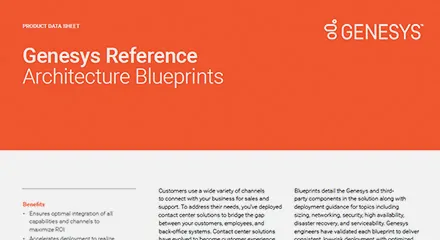Customers use a wide variety of channels to connect with your business for sales and support. To address their needs, you’ve deployed contact centre solutions to bridge the gap between your customers, employees, and back-office systems. Contact centre solutions have evolved to become customer experience platforms, reflecting the vast number of channels, intelligence, and analytics that they offer to orchestrate optimal service experiences.
Deploying your customer experience platform correctly is critical to maximise your return on investment and the benefits it delivers for your customers, employees, and operational staff. The Genesys Customer Experience Platform has been deployed globally in organisations large and small to meet the needs of businesses just like yours, enabling us to establish best practices and package this knowledge within architecture blueprints.
Genesys Reference Architecture Blueprints are a framework to help partners and customers deploy a proven architecture to meet common business use cases. They deliver a set of standardised tools and proven design patterns based on analysis of real-world implementations. They are a tool to help to understand and replicate best-practice approaches. These blueprints describe a proven architecture on which standard and custom use cases are layered. Genesys has defined standard use cases that include the business benefits, logic, and analytics to help you quickly see measurable results.
Blueprints detail the Genesys and thirdparty components in the solution along with deployment guidance for topics including sising, networking, security, high availability, disaster recovery, and serviceability. Genesys engineers have validated each blueprint to deliver consistent, low-risk deployment with optimised business operations.
